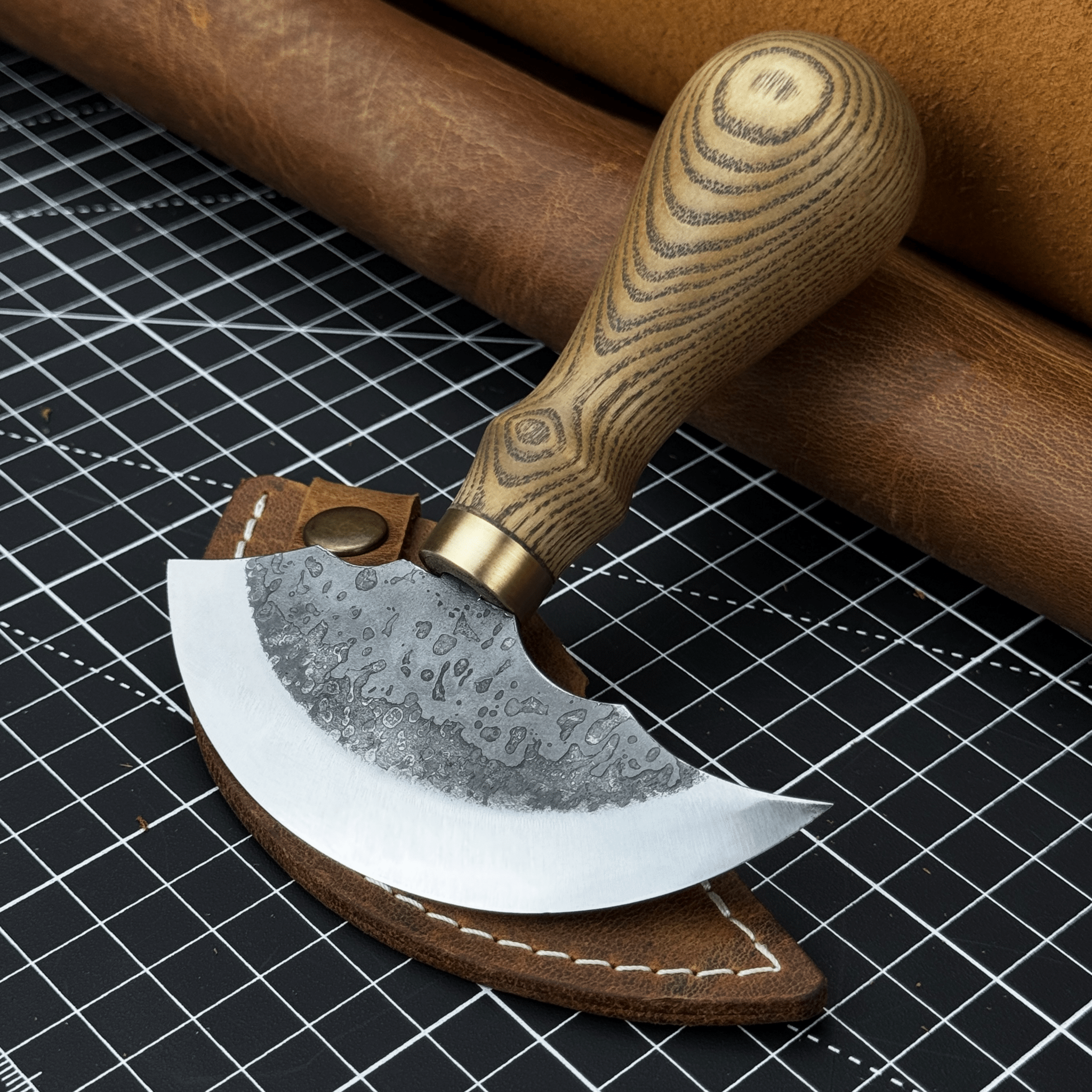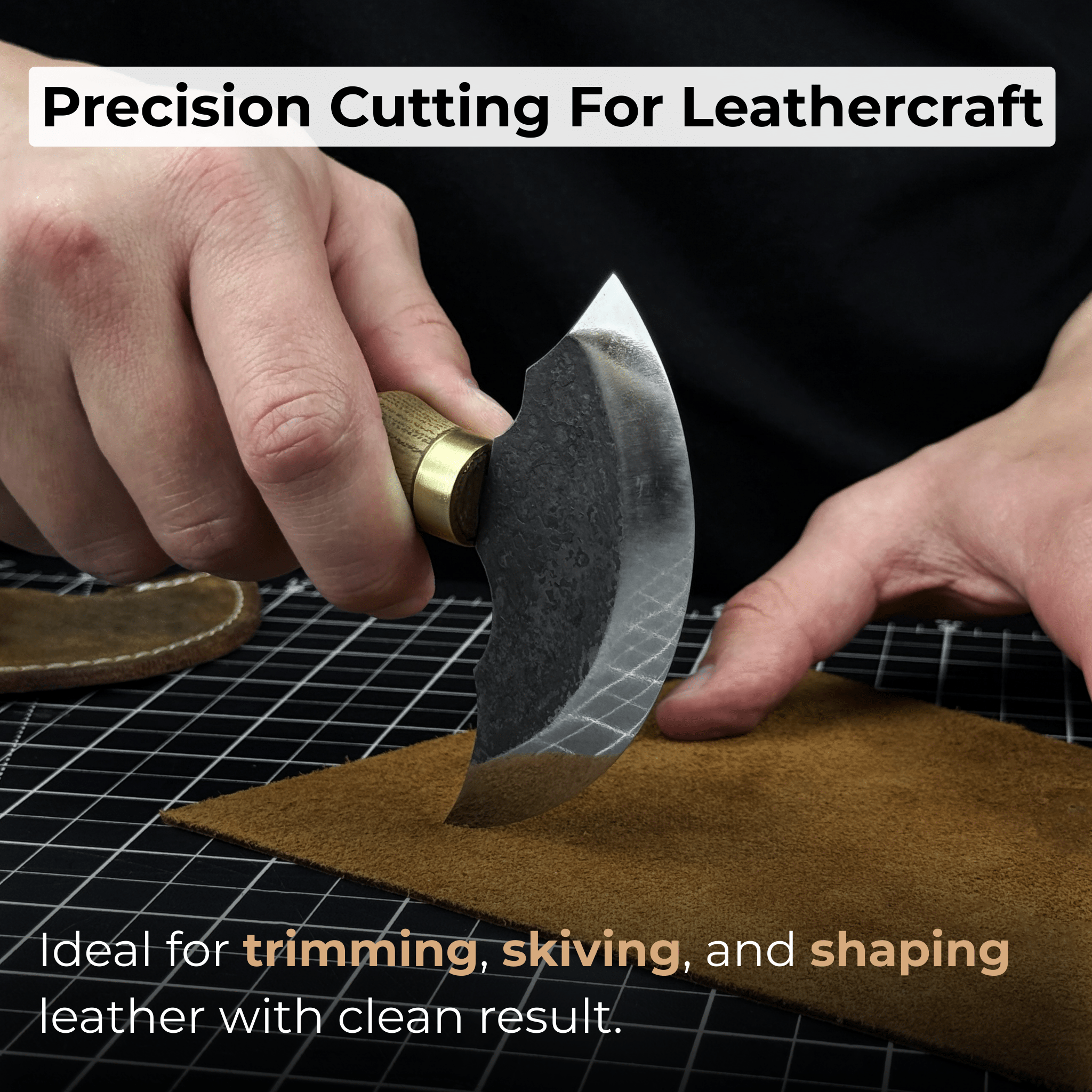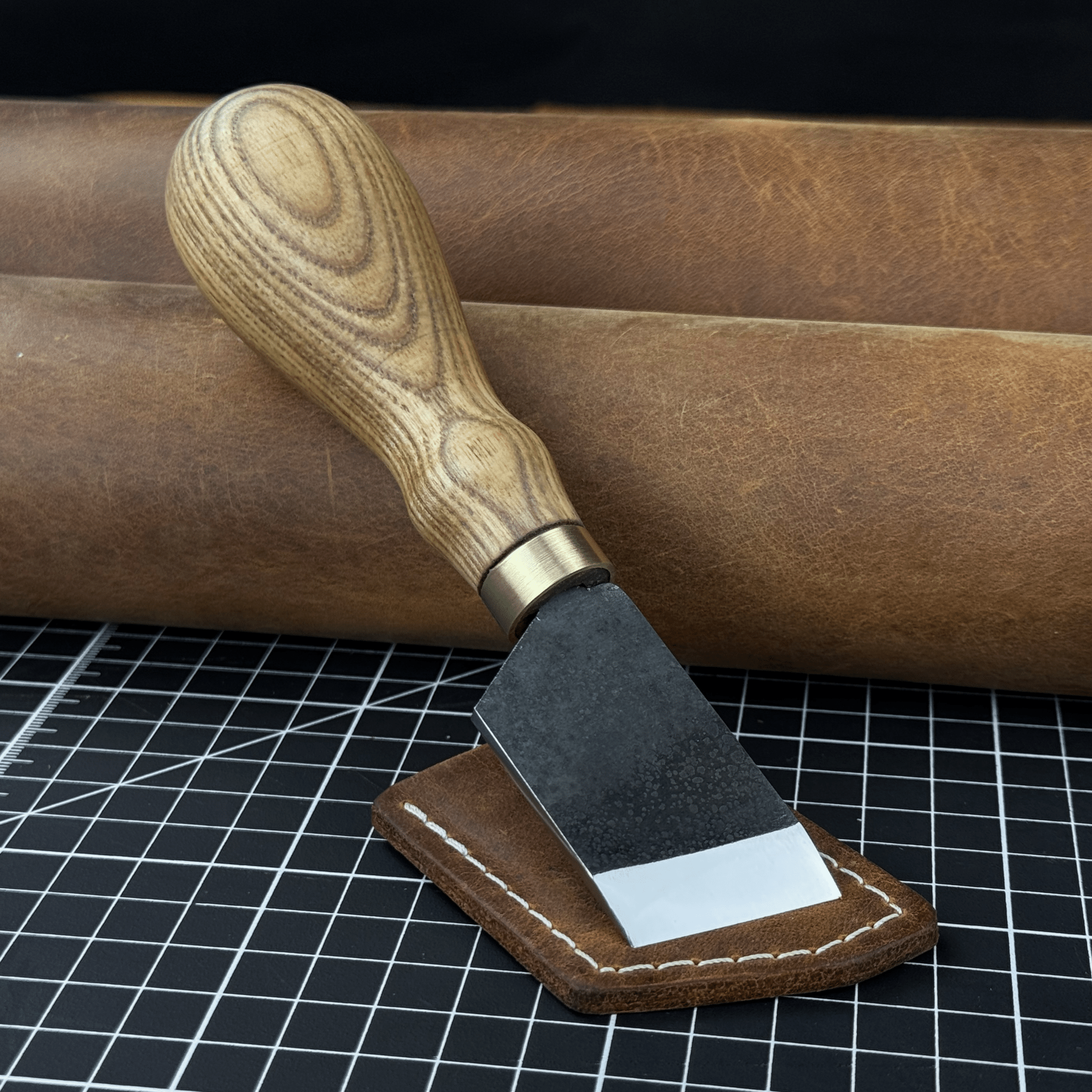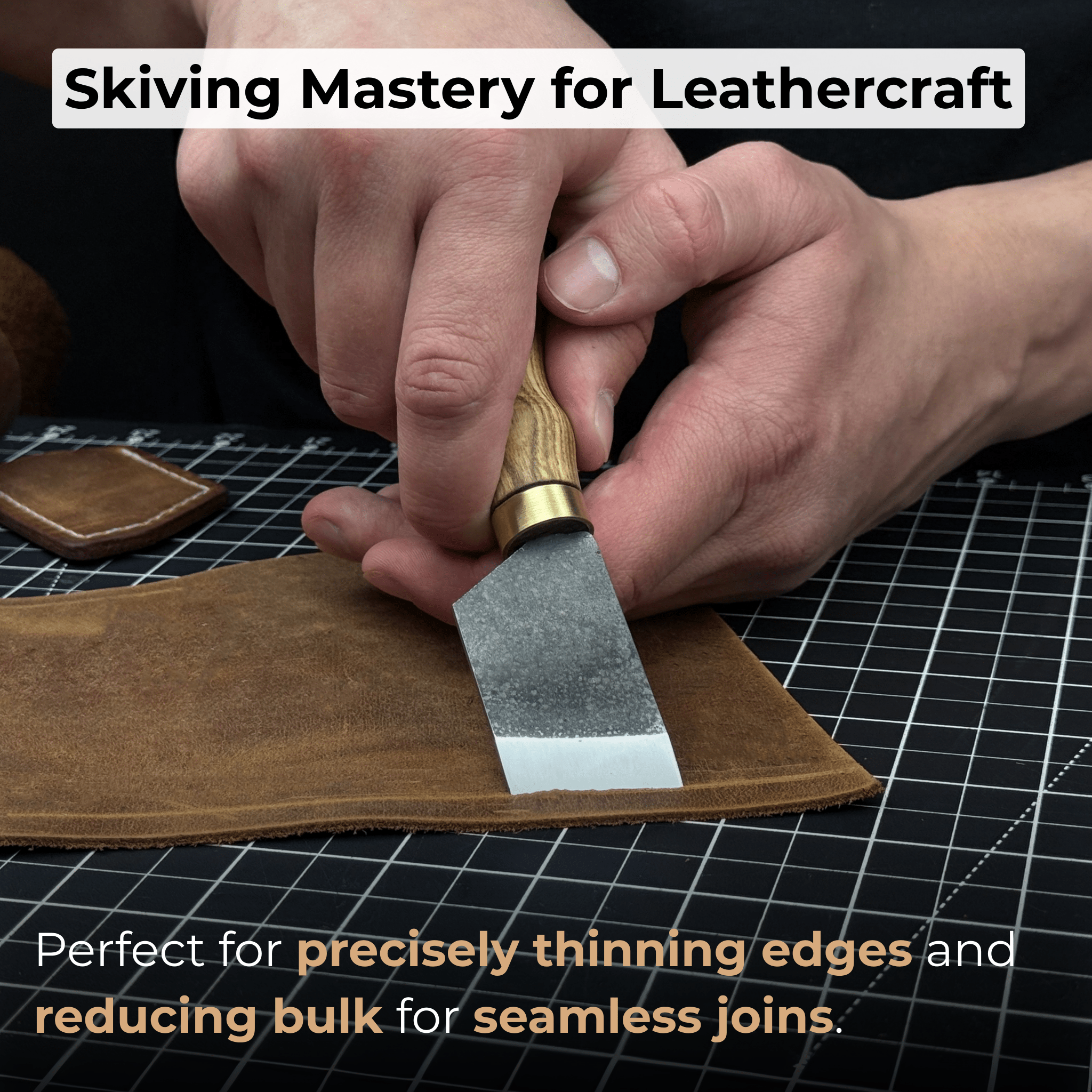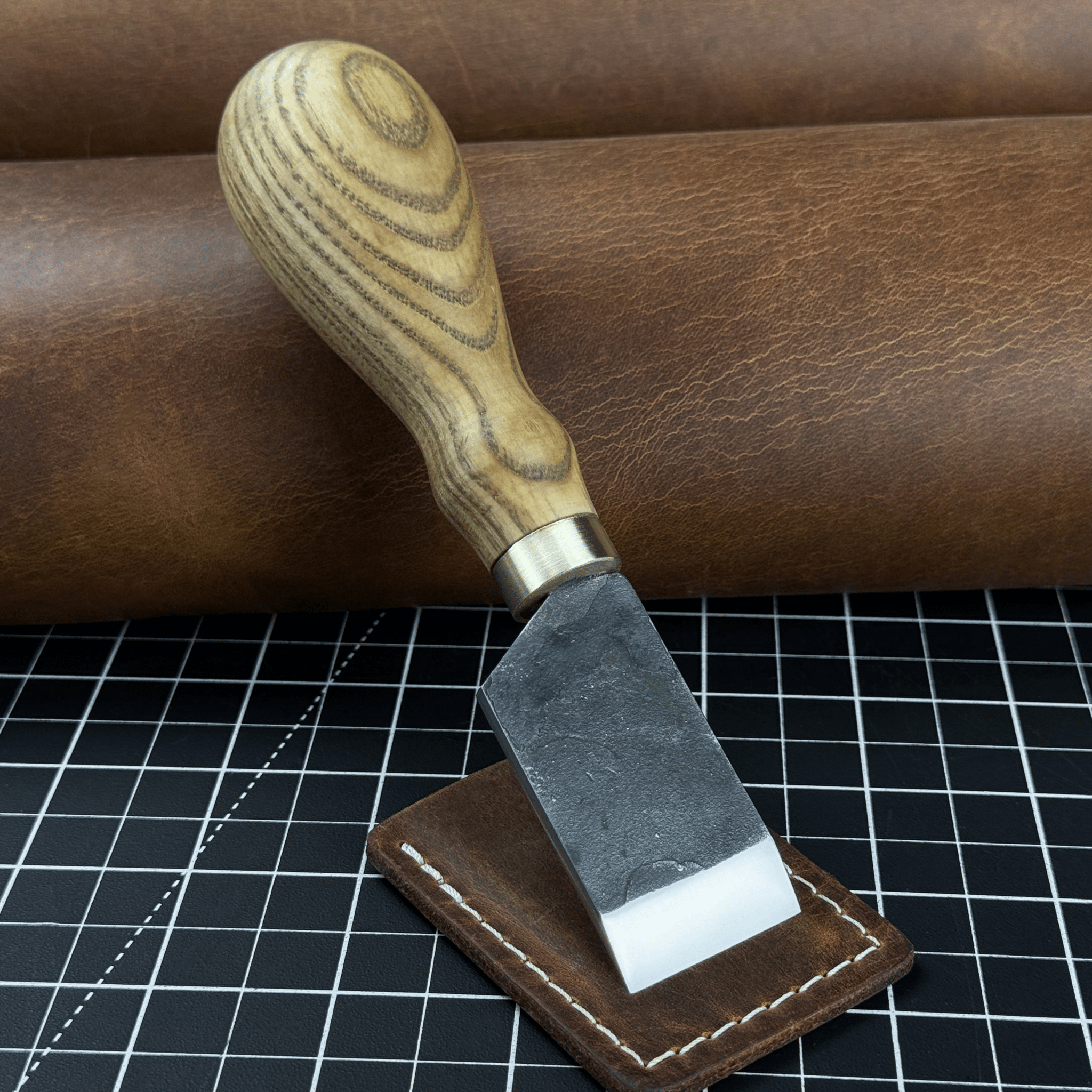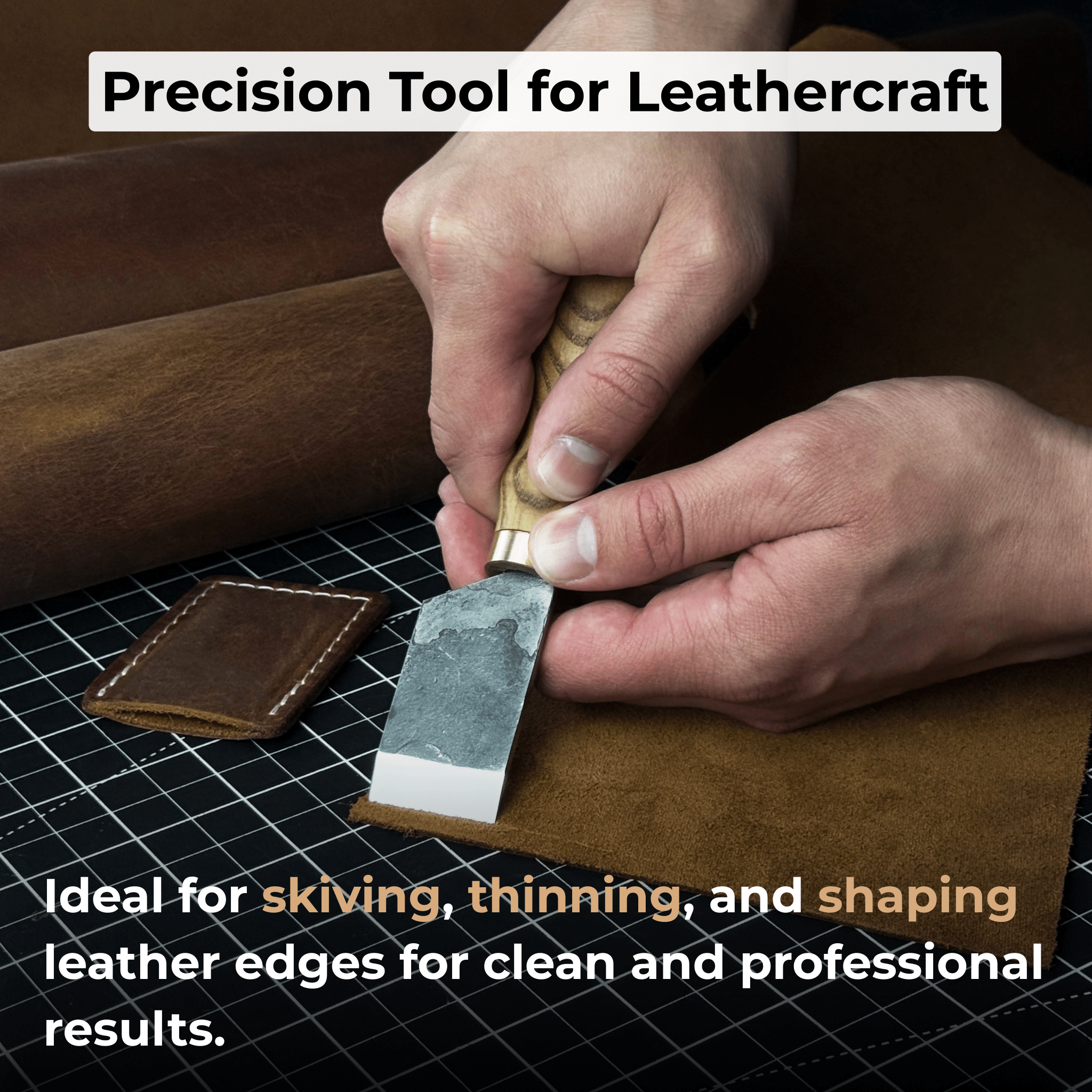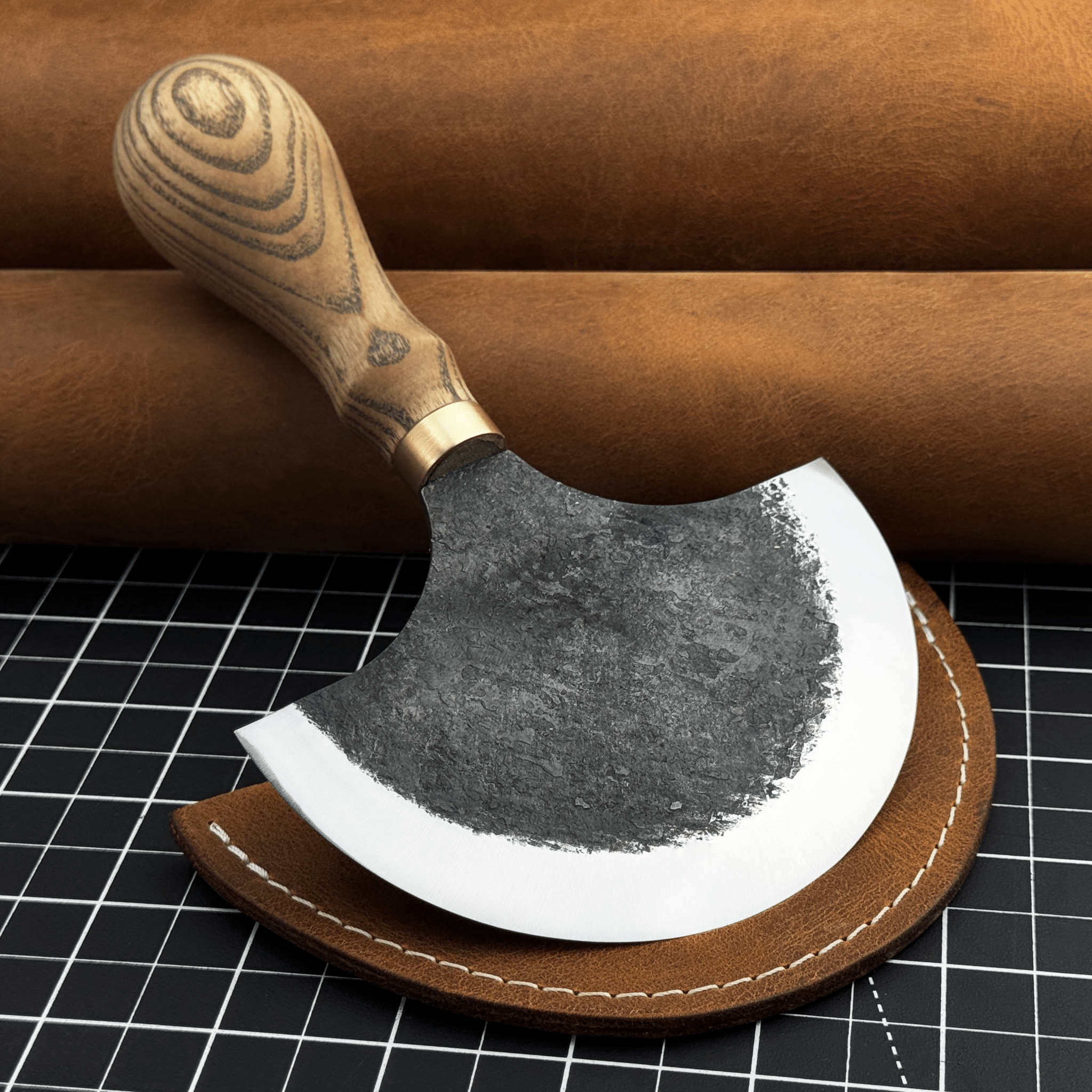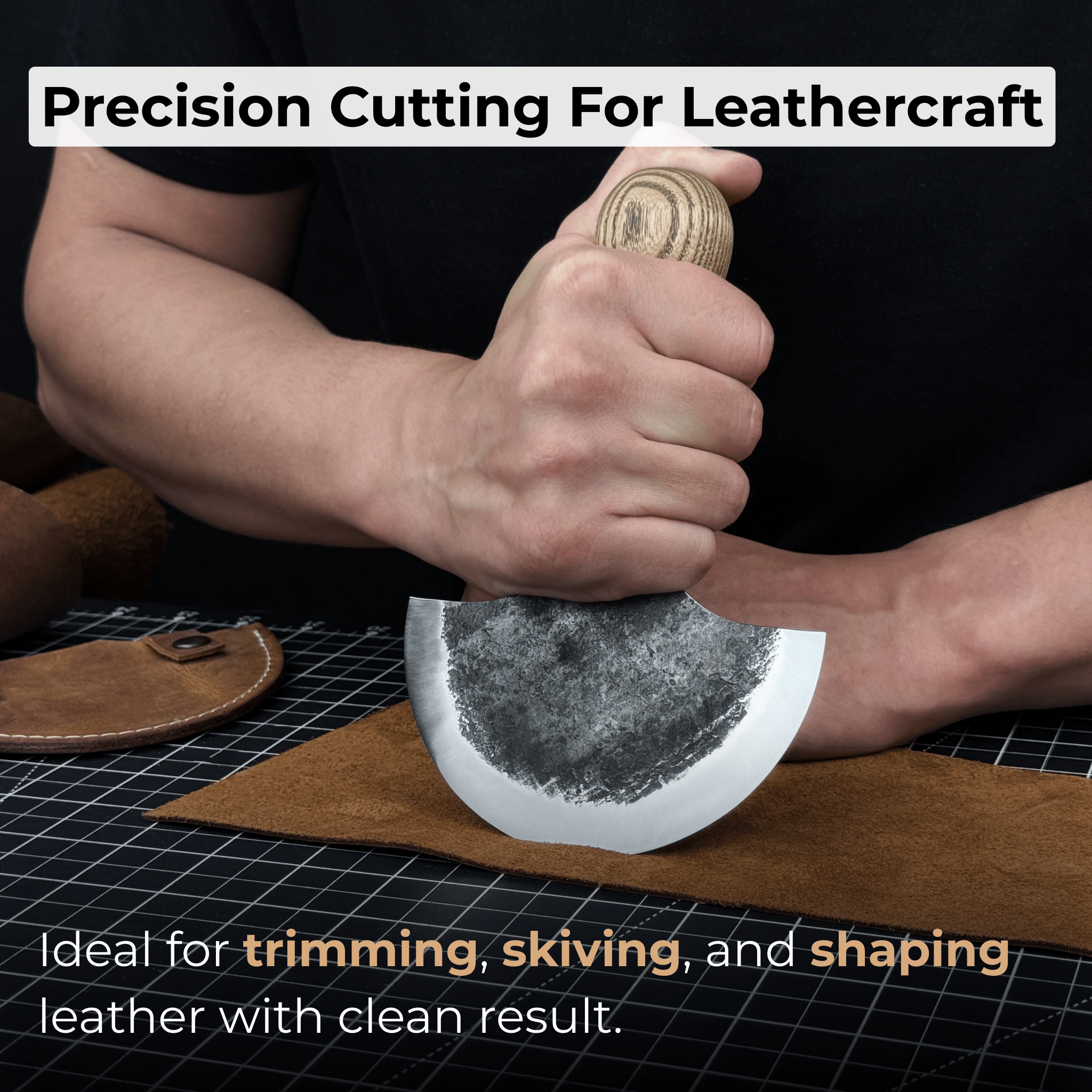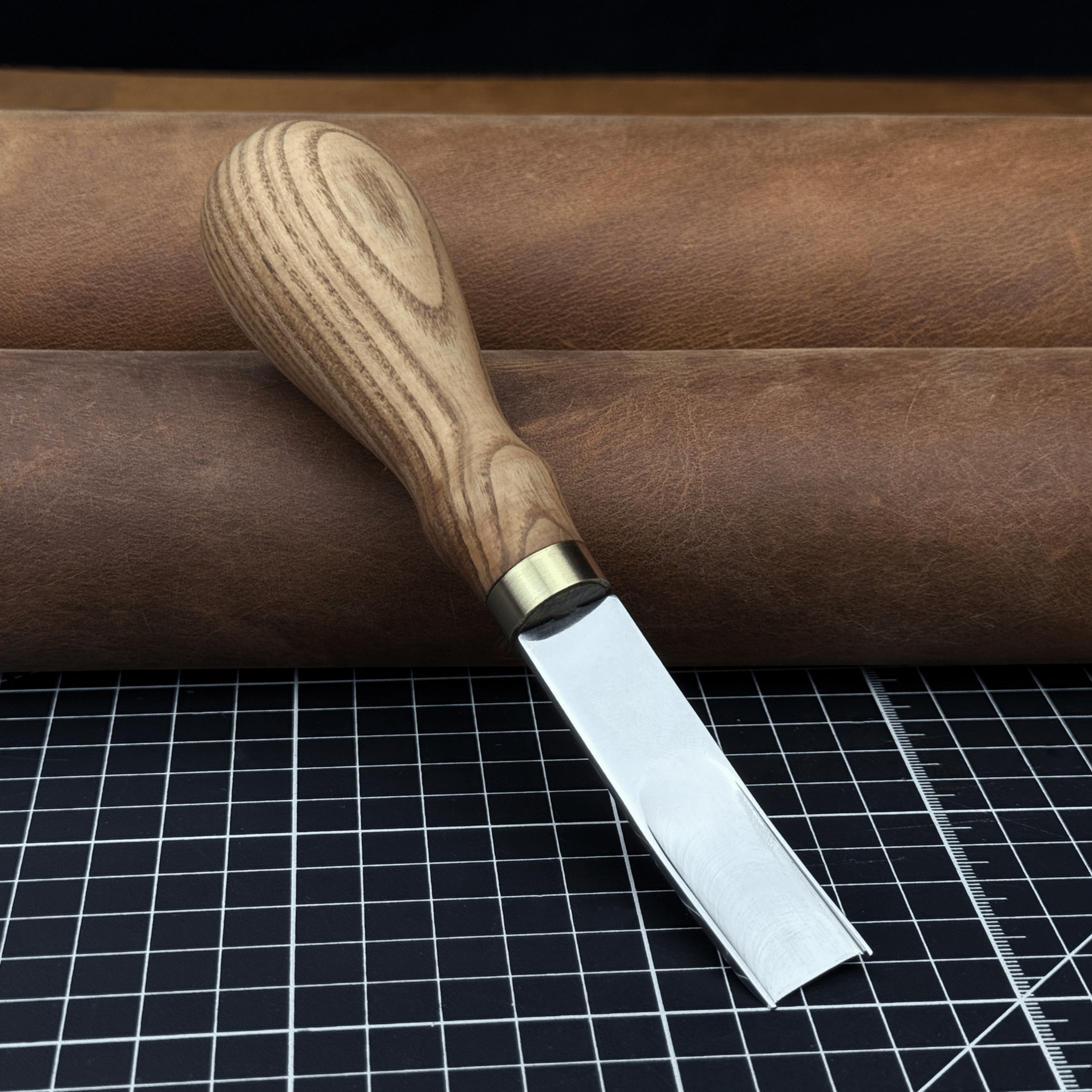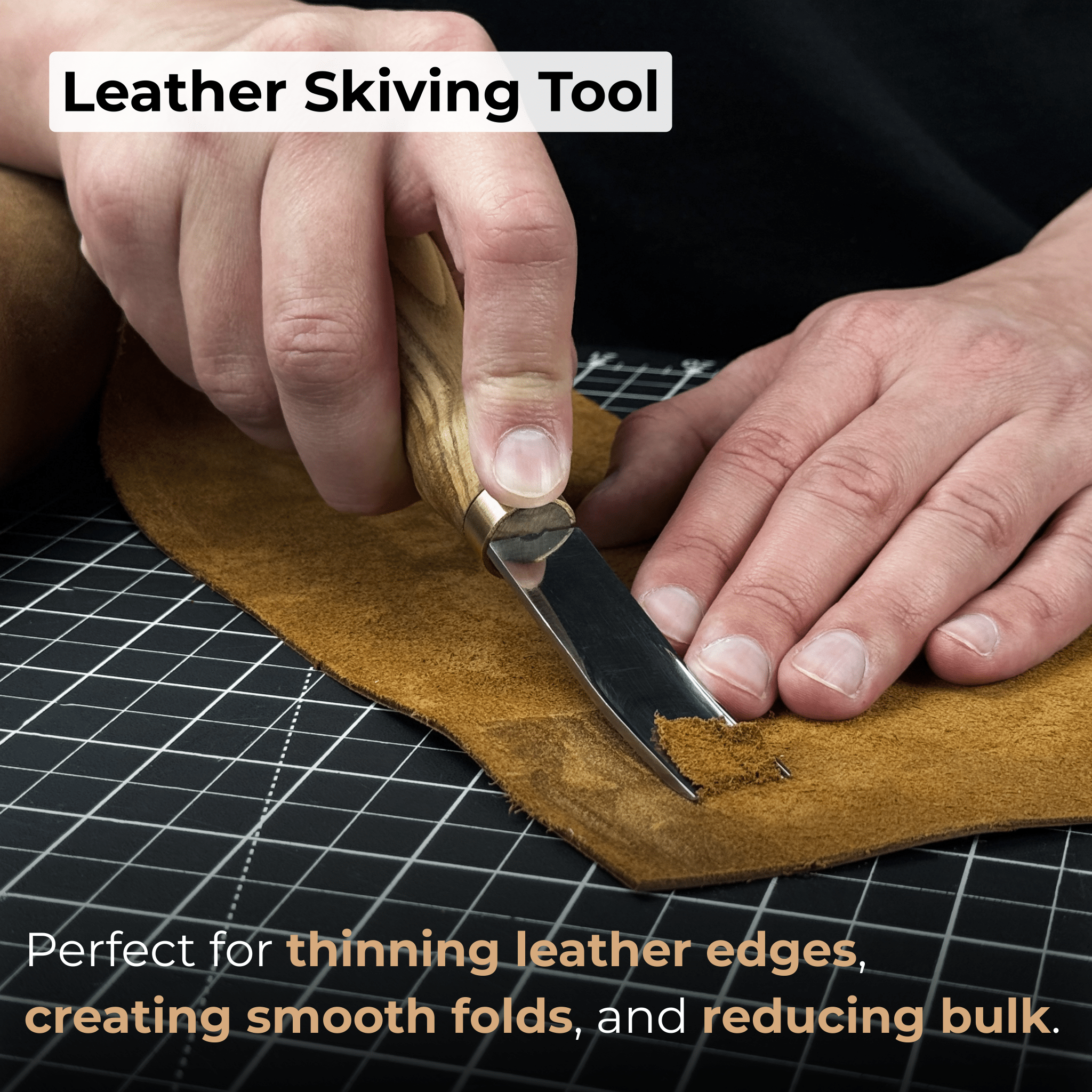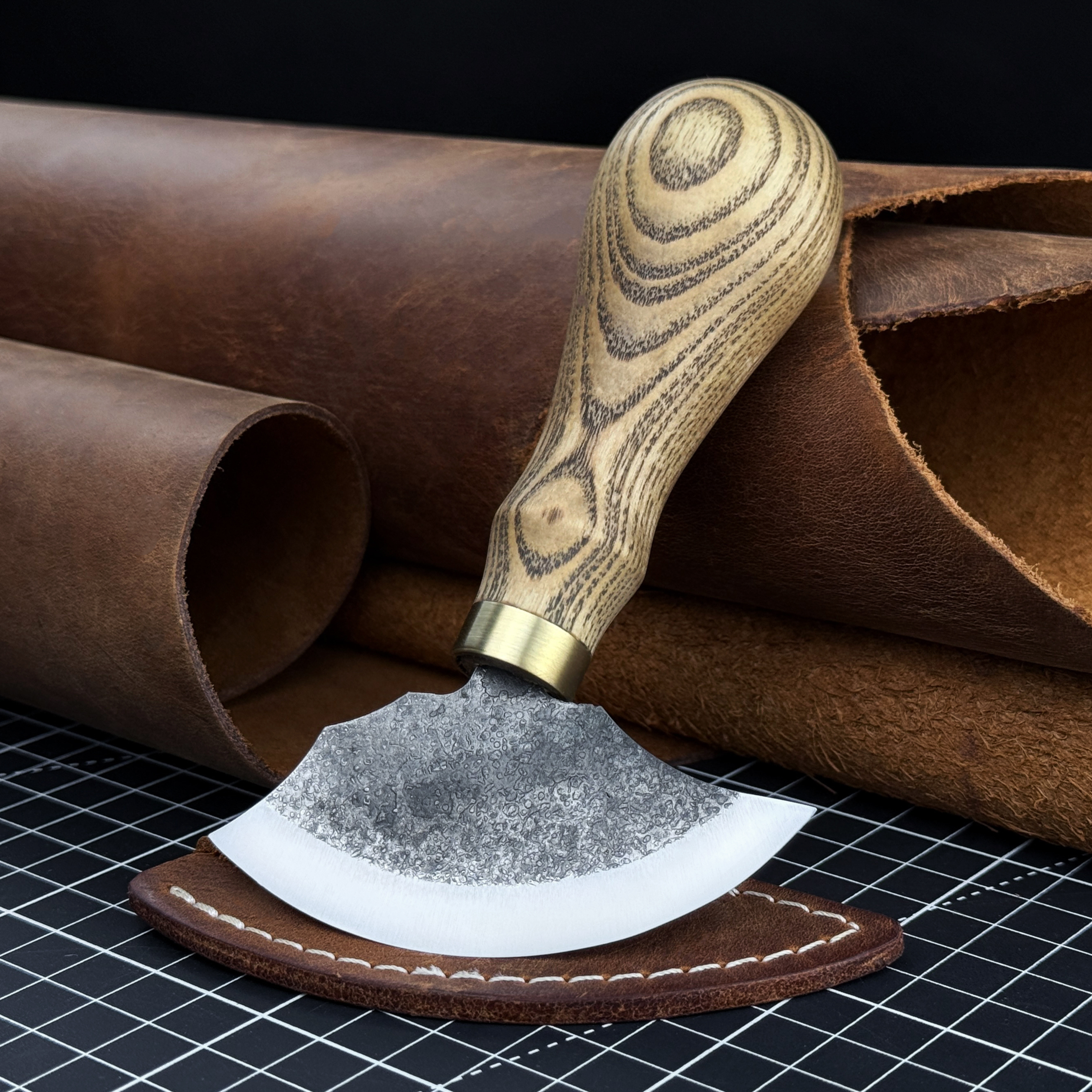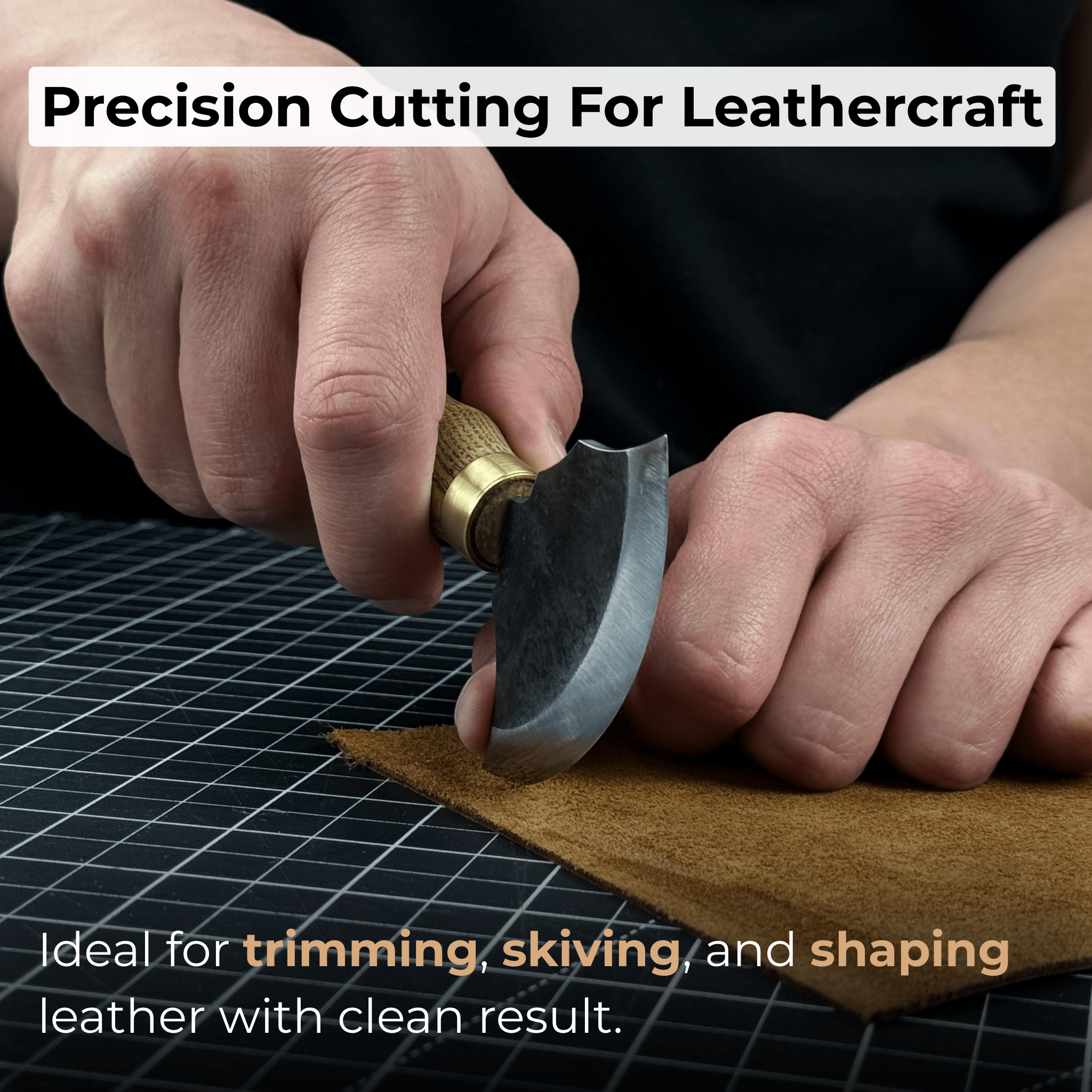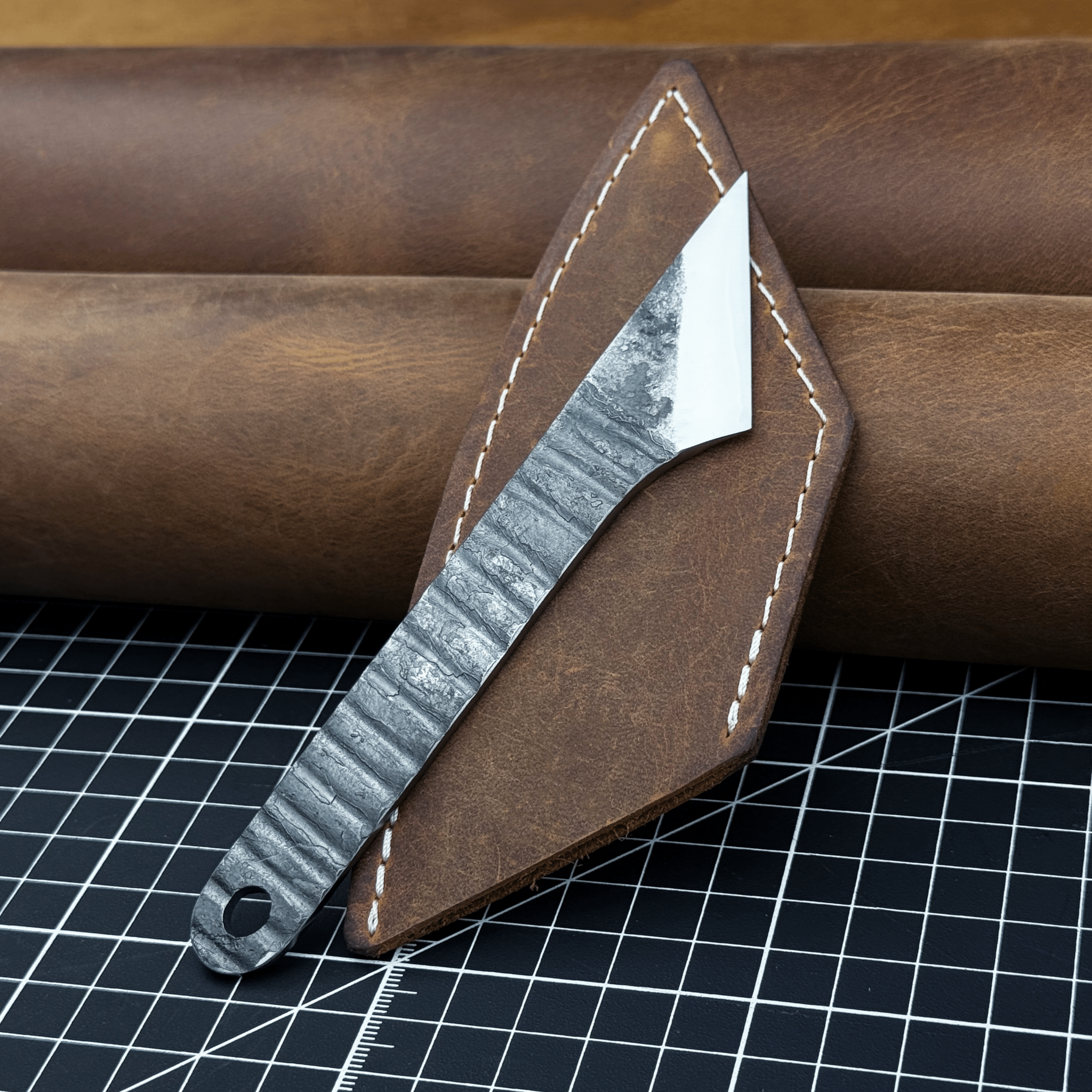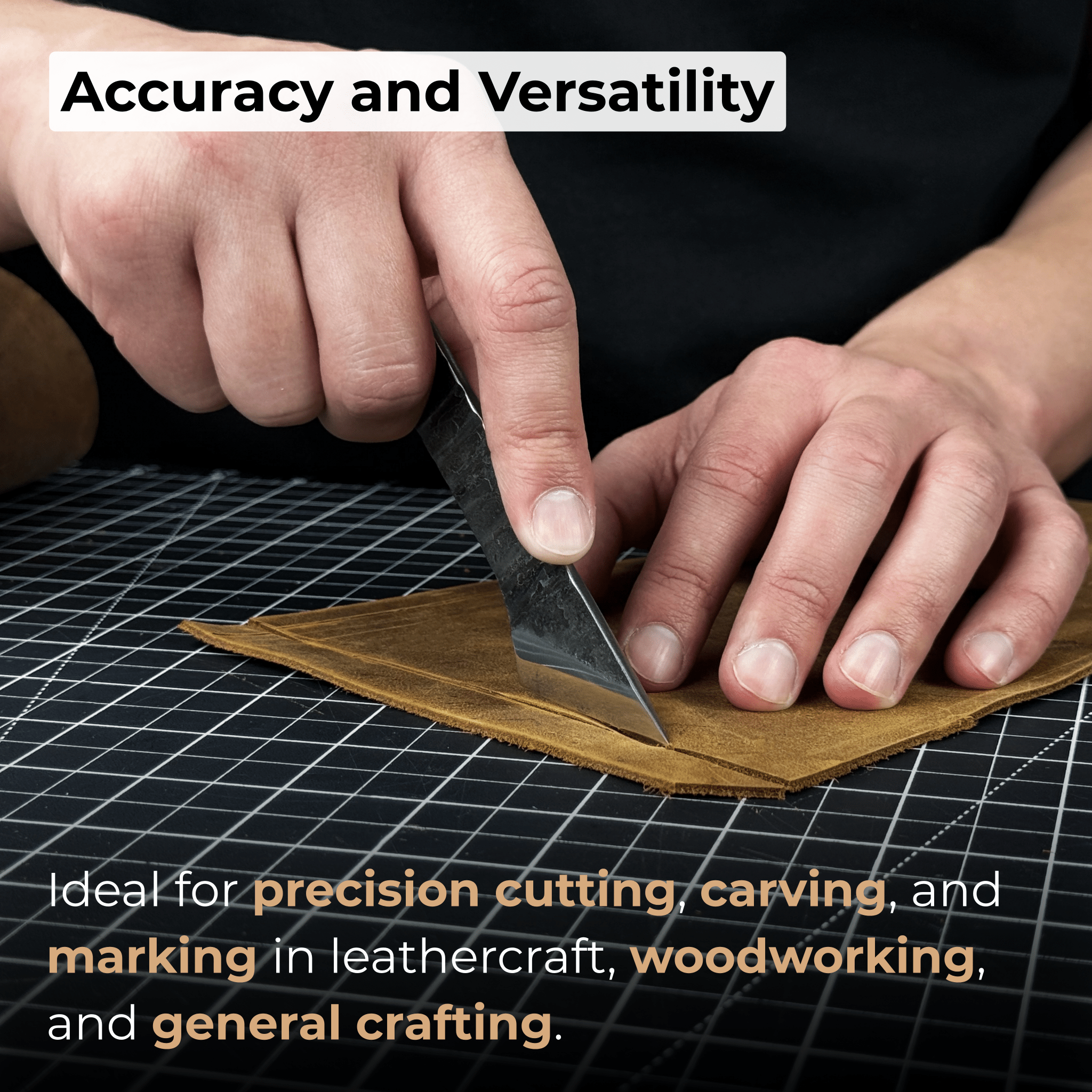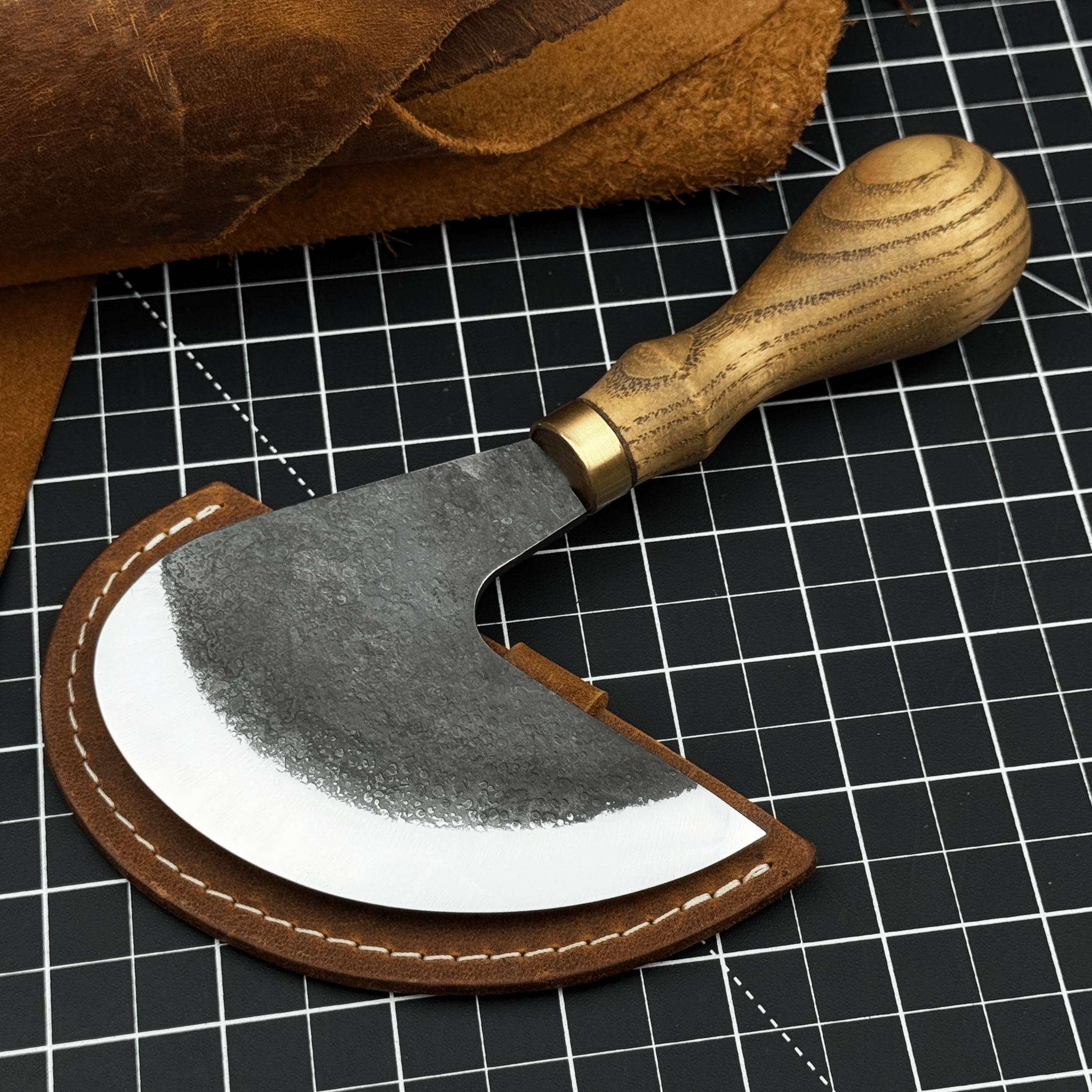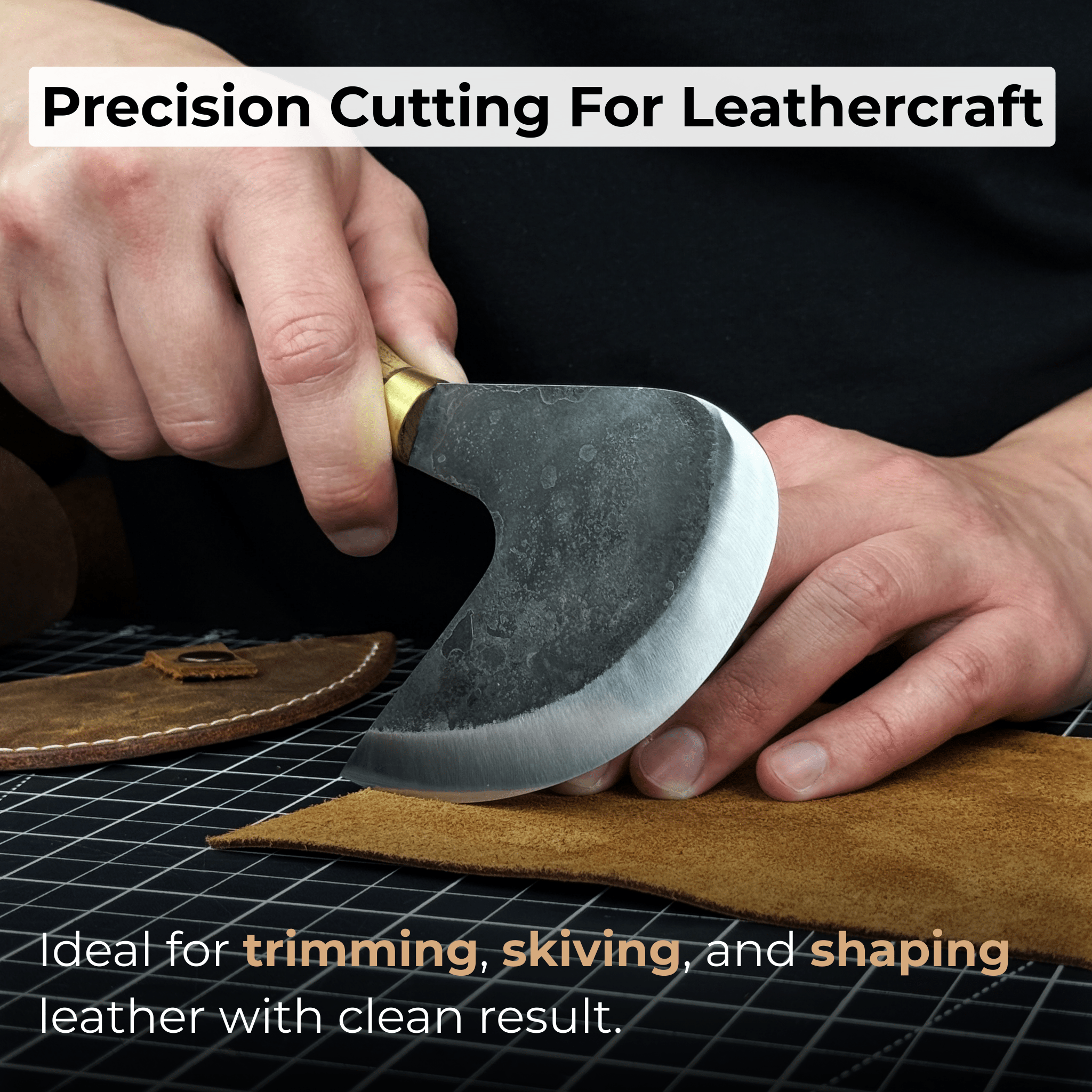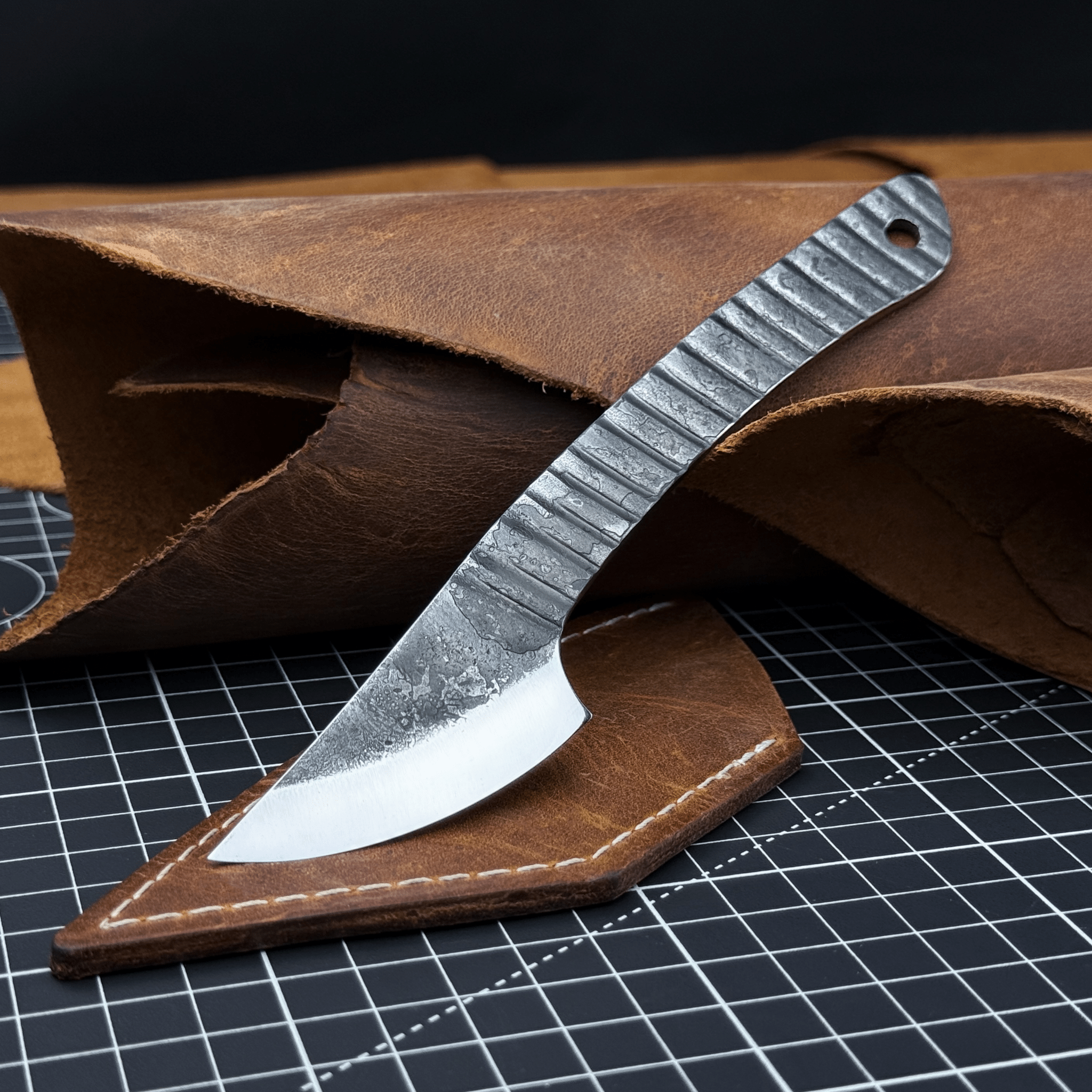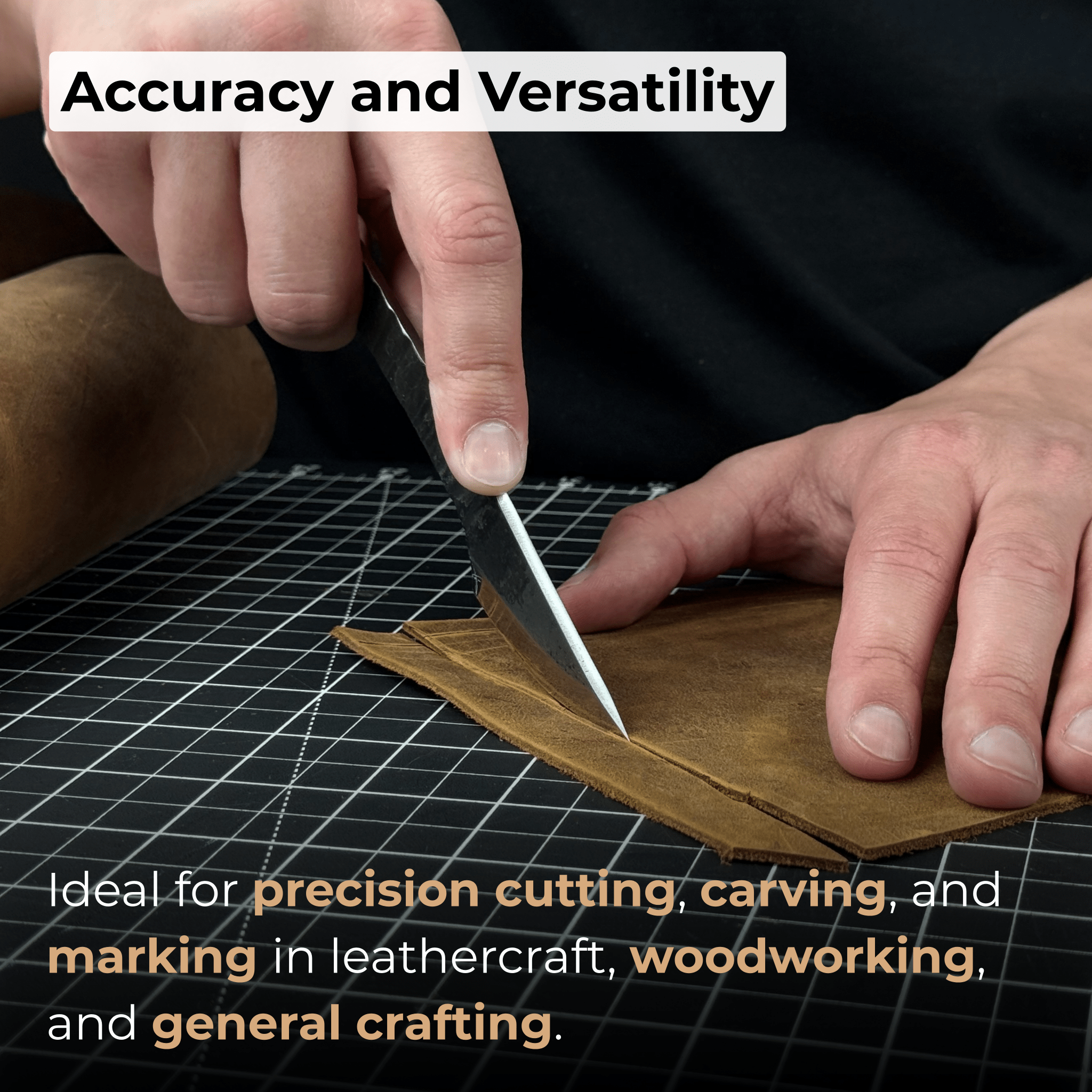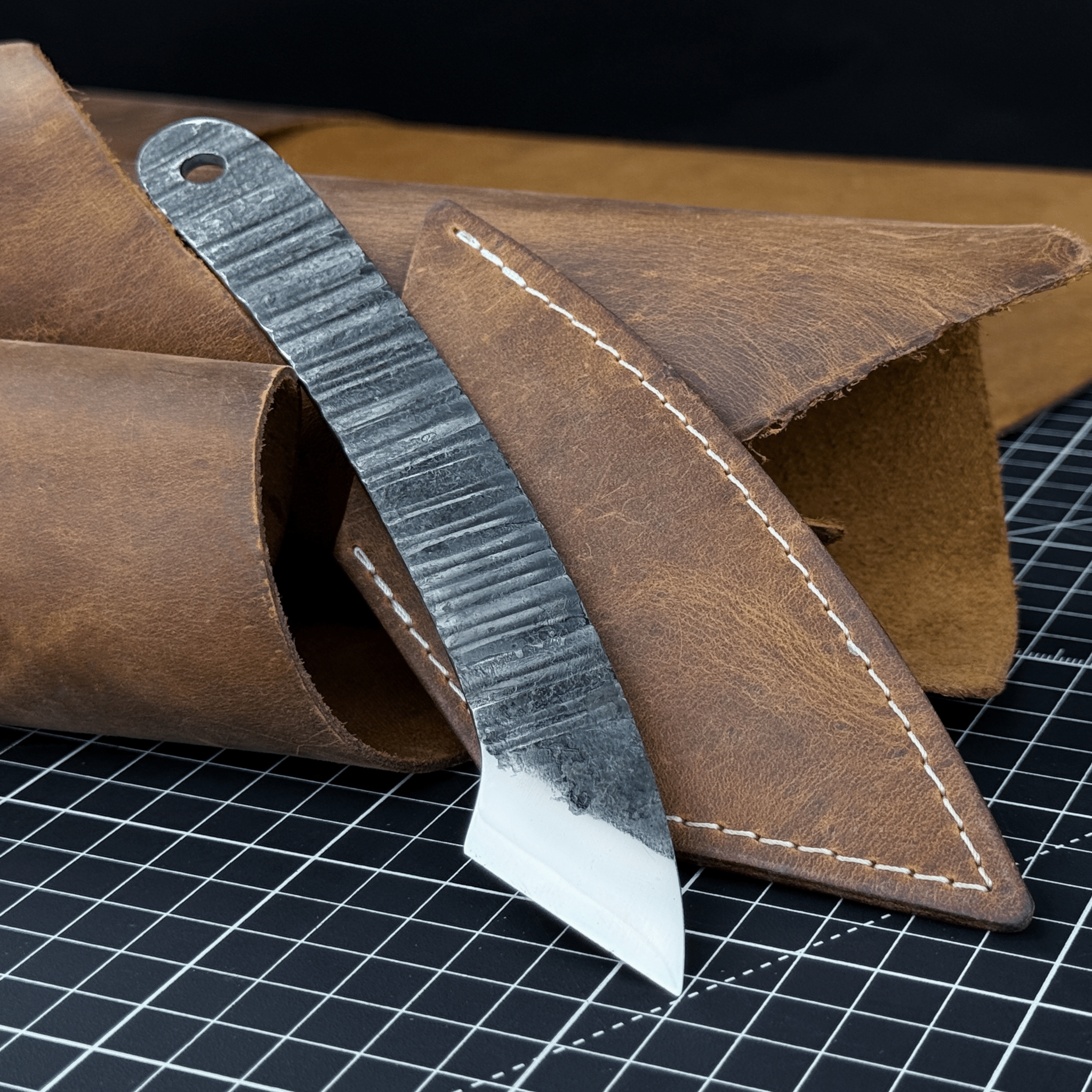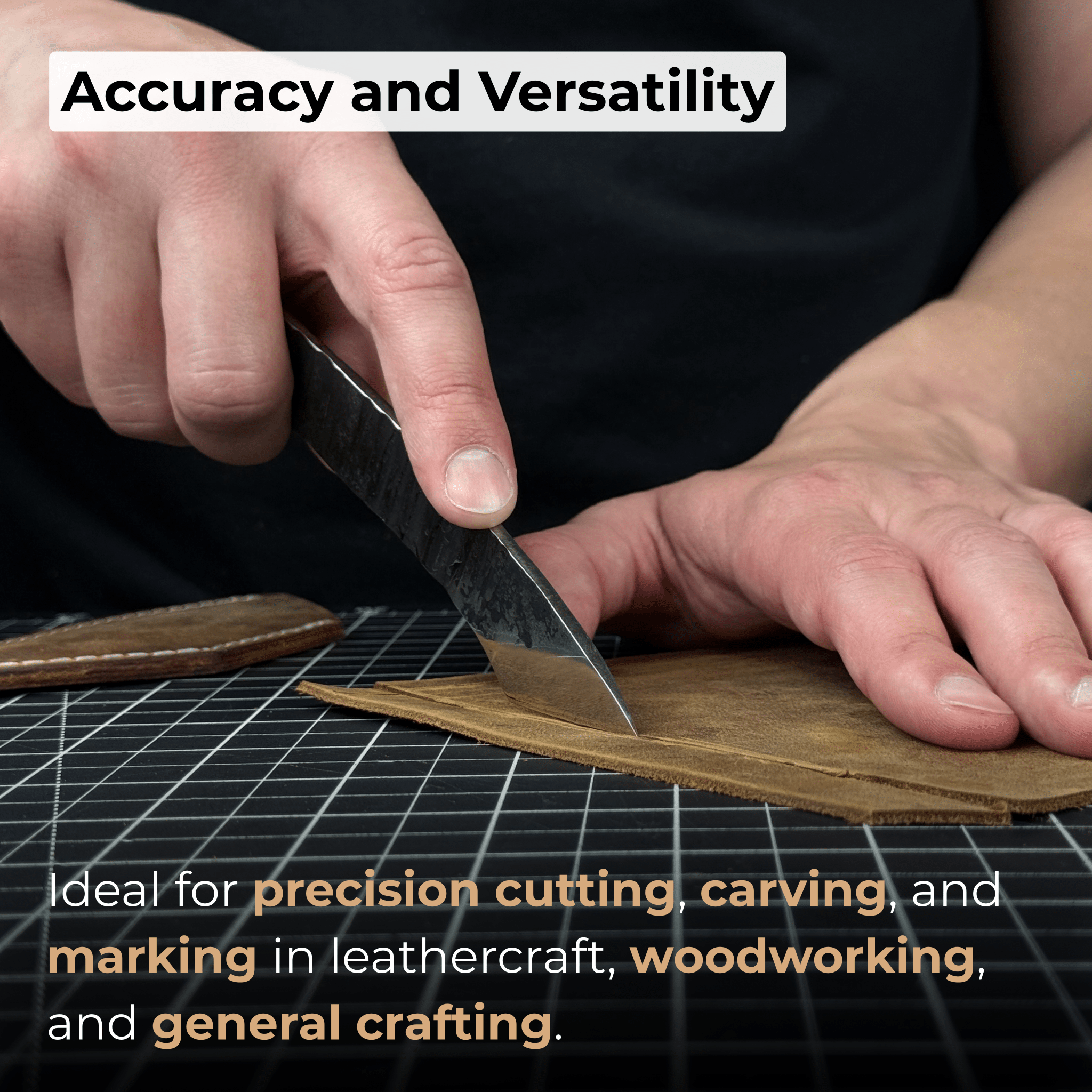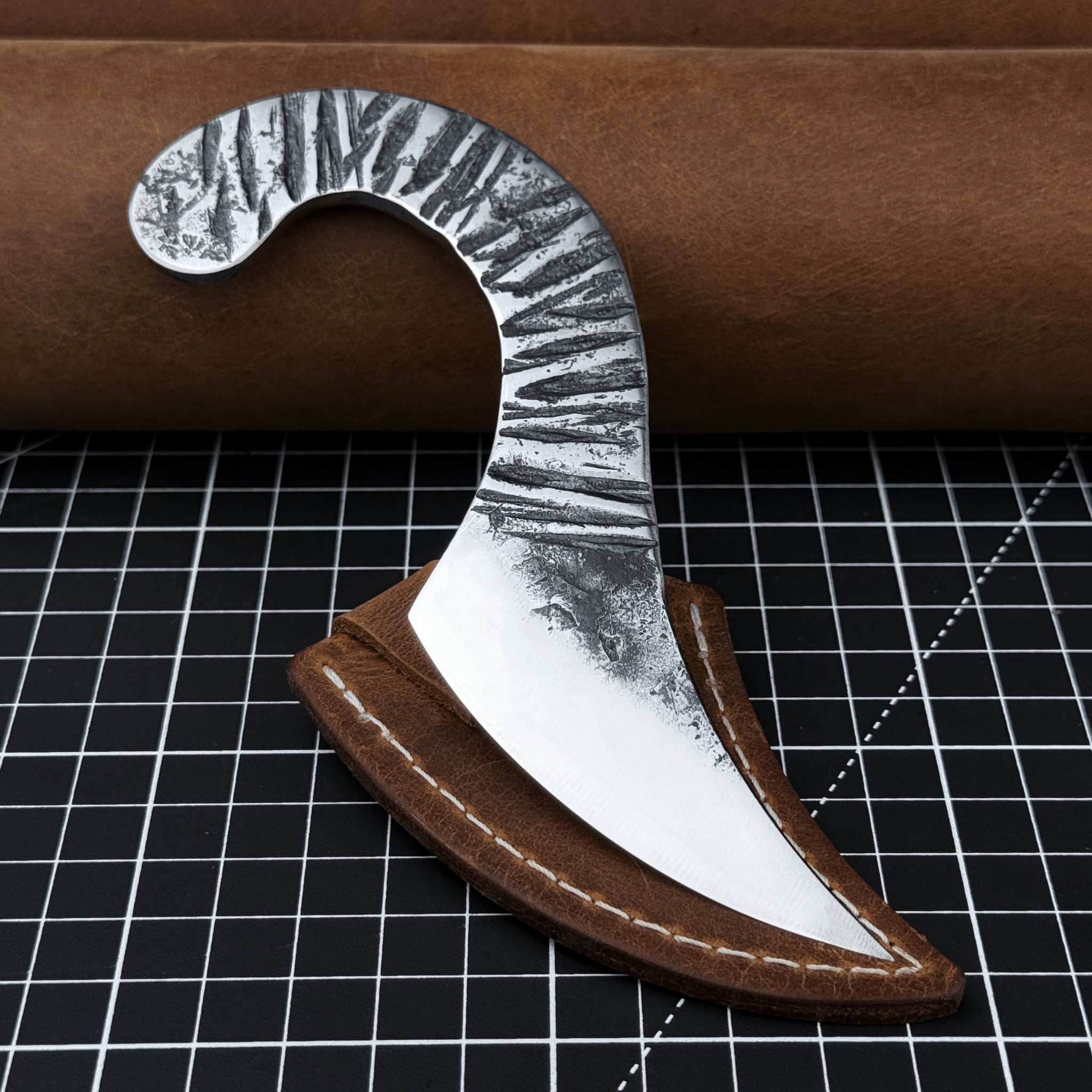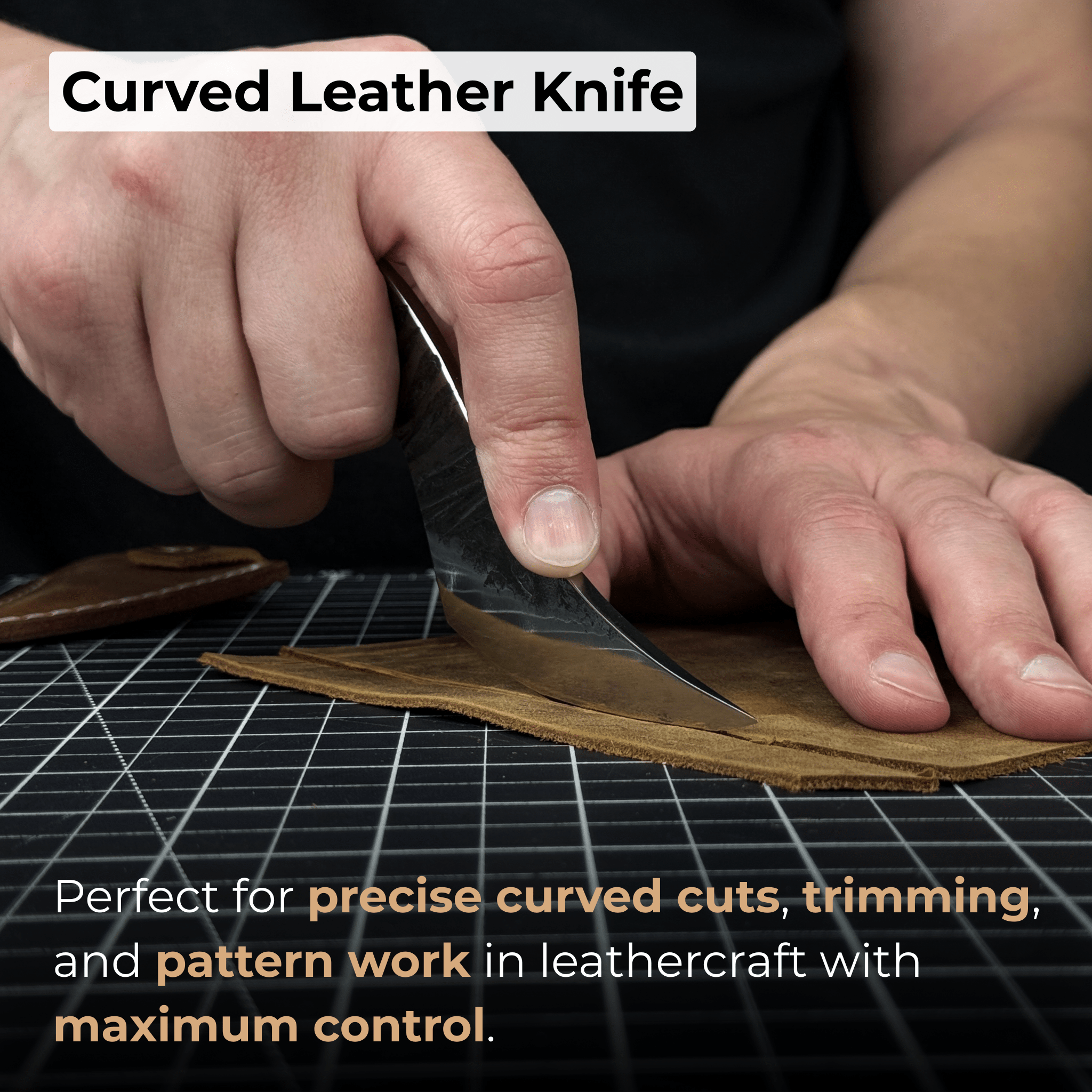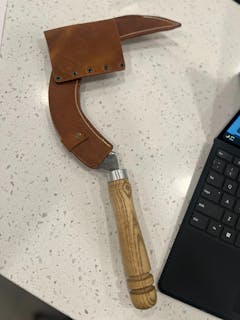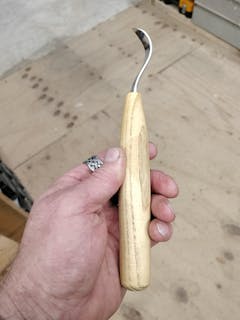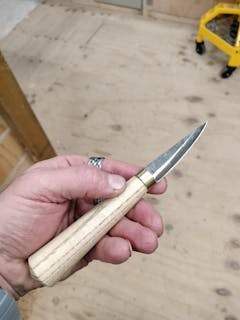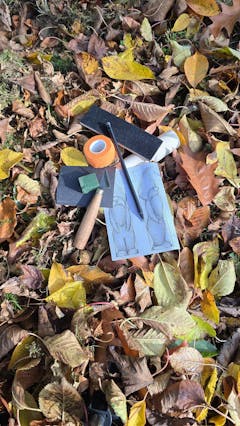Leather Round Knife, 10 cm (3.9 inches)
Angled Leather Skiving Knife, 3 cm (1.18 inches)
Straight Leather Skiving Knife, 3 cm (1.18 inches)
Leather Round (Half Moon) Knife, 10.5 cm (4.1 inches)
Leather Edge Skiver, 4-16 mm (0.16-0.63 inches)
Small Leather Round Knife, 8 cm (3.15 inches)
Marking Knife Kiridashi with leather sheath, 4 cm (1.57 inches)

Marking Knife Kiridashi with Rounded Blade, 5,5 cm (2.17 inches)
Marking Knife Kiridashi, 3.5 cm (1.38 inches)
Skiving Knives: The Essential Tool for Leatherworking Mastery
Leather skiving is a technique used to pare down sections of leather to make the material more manageable, and skiving knives are primarily used for that purpose. This process is essential in leathercraft, as it creates smooth transitions, refined edges, reduces bulk for better stitching without sacrificing structure, and helps achieve a more professional final look.
While machine skivers are powered tools created for higher efficiency in skiving large or multiple pieces of leather, hand tools like skiving knives come at a significantly lower price and are way easier to handle.
Leather skiving knives are also preferred for their high level of control over the depth and angle of the cut. They can be applied to various types of leather thicknesses, allowing for more customized shaping and thinning compared to machine skivers. Skiving knives require minimal setup to get started and give that unique handcrafted feel people seek.
A typical skiving knife features a single bevel blade with a low-angle design that facilitates smooth, even cutting, and a straight or slightly curved blade.
Let’s explore its structure in more detail now.
Anatomy of a Skiving Knife: What Sets It Apart
Blade Geometry: Understanding the Unique Shape of Skiving Blades
Every leather skiving knife is characterized by its high blade sharpness, which guarantees clean, precise cutting without tearing the leather. Blade types vary greatly, serving specific leatherworking tasks.
- Straight Blade
Shape: Features rectangular or slightly tapered blade.
Use: Suitable for general-purpose skiving and thinning large areas.
- Curved Blade (Round Blade)
Shape: This type of skiving tool has a curved edge.
Use: Better suited for precise cutting, especially in tight areas, allowing even pressure while skiving.
- French Skiver
Shape: Wide, flat blade with a chiseled tip.
Use: Excellent for skiving edges, particularly near seams or for folding edges.
- Japanese Skiving Knife
Shape: Long, straight blade, featuring a very sharp tip.
Use: Equally good for skiving and cutting due to its extreme sharpness.
- Bevel Point Blade
Shape: Diagonal or sloped edge.
Use: Excels at a slanted angle skiving, used for gradually thinning specific material areas.
- Oblong Skiving Blade
Shape: A leather skiving knife of this type features an elongated oval blade with a flat or rounded cutting edge.
Use: Provides more accurate skiving on larger surfaces and creates smoother transitions.
- Pointed Blade
Shape: Pointed or V-shaped.
Use: Suited for detailed work in small areas, such as corners or complex patterns.
Handle Design: Comfort and Control in Leatherwork
Ergonomically designed handles fit naturally in the hand, which is especially important for very labor-intensive tasks that require time and effort.
A comfortable grip ensures that a skiving knife for leather is easy to handle, absorbing shock better and reducing hand fatigue. Grip textures vary between manufacturers and depend on the handle materials. The more wear-resistant handles are made from wood and composite materials.
Leather skiving knife handles come in different lengths and thicknesses, which also impact grip comfort. If a skiving knife handle is too short or too thin, it becomes difficult to grip securely.
Most skiving knives have fixed handles integrated into the knife’s design. However, some manufacturers offer modular skiving knives with replaceable handles, allowing for some customization.
Common handle shapes include:
- Straight Handles: Linear handles providing a straightforward grip, often used in general-purpose skiving knives.
- Curved Handles: Fit the natural curve of the hand, offering better ergonomics, sometimes specialized leather knives come with finger grooves or textured surfaces.
- Flat Handles: Allow for a low-angle grip, usually used in paring knives and lap skivers for precise control.
- Round Handles: Offer better maneuverability, often used in Japanese skiving knives, made from wood or composite materials.
The Importance of Balance: How It Affects Your Skiving Precision
In craftsmanship like leatherworking, achieving a sleek, accurate appearance is the final goal.
A properly balanced skiving tool brings you closer to that goal. When the skiving knife weight is evenly distributed between the blade and the handle, leatherworkers can make more controlled leather cutting, essential for consistent skiving thickness.
Good balance also helps maintain a steady hand for longer periods, improving the overall quality of the leatherwork and contributing to safety by reducing the likelihood of accidental slips.
Choosing the Right Skiving Knife for Your Leatherworking Projects
Blade Materials: Exploring Different Steel Options for Skiving
The skiving blade plays a crucial role in achieving the perfect thickness for edges, folds, and seams. Understanding the pros and cons of different steel blade materials available for skiving knives is key to selecting the right tool for your leathercraft needs.
- Carbon Steel
Pros: Leatherworking tools with carbon steel blades are easy to maintain, extremely durable, they can withstand rigorous use and are reasonably priced.
Cons: Vulnerable to rusting, requires regular skiving knife care like oiling to prevent corrosion.
- D2 Tool Steel
Pros: Excellent wear and abrasion resistance, holds a sharp edge well.
Cons: Due to high hardness, it may be more difficult to sharpen, more expensive than 1095 steel.
- Stainless Steel (440C, VG-10, and more)
Pros: Rust-resistant, needs less frequent maintenance compared to carbon steel blades.
Cons: Does not hold an edge as long as carbon steel, can be more expensive depending on the alloy.
- High Carbon Stainless Steel
Pros: Provides sharpness, good edge retention, and corrosion resistance, suitable for heavy use.
Cons: Comes at a higher price point than standard stainless or carbon steels.
Fixed vs. Replaceable Blades: Pros and Cons
Some seasoned leatherworkers explain that a leather skiver knife with replaceable blades can be a better choice for beginners, as they are widely available, affordable, and simple to use. This leather knife offers versatility and quick blade changes, making tool maintenance easy. Some replaceable blades can even be resharpened for extended use.
Fixed-blade leather skiving knives require more maintenance but can last a lifetime with proper care. These knives are usually more durable and suitable for heavier or more advanced leatherwork.
Let’s weigh the pros and cons:
Fixed Leather Skiving Knife Blades
Pros: More robust, handle heavy use without the risk of breaking or detaching, offer stability and control, easier to clean due to no moving parts.
Cons: Require regular sharpening, less portable, can be more expensive.
Replaceable Leather Skiving Knife Blades
Pros: Easily changeable blades, versatile with various blade types, more compact design.
Cons: Not as durable as fixed blades, ongoing blade replacement costs, less stable and controllable, affecting precision.
Factors to Consider: Leather Thickness, Project Type, and Personal Preference
Heavy-duty leathercraft projects, like belts, saddlebags, and shoes require thicker leather to avoid compromising strength.
For finer crafts, such as wallets or book covers, thinner leather is a better choice.
Consider these factors based on skill level:
- For Beginner Craftsmen
Types of leather: Vegetable-tanned leather is easier to work with, as it tends to respond well to tooling and dyeing. Chrome-tanned leather is affordable and good for practice.
Leather thicknesses: 2-3 oz for fine crafts like keychains and wallets; 4-5 oz for larger projects like belts and simple bags.
- For Advanced Leatherworkers
Types of leather: Full-grain leather offers high quality and durability for high-end crafts.
Leather thicknesses: 6-7 oz for sturdy leather items like straps, belts, and heavy-duty bags; 8-9 oz for very durable items like holsters and thick belts.
Stories from the Workshop: Skiving Knives in Action
Practicing various skiving techniques is crucial to mastering the craft and taking your projects from functional to finely finished. Here are several efficient techniques to try:
- Beveled Edge Skiving: A flat skiving knife for leather is commonly used to bevel edges, reducing bulk in a gradual manner. This skiving technique ensures neat, slim edges and facilitates stitching.
- Even Skiving with a French Edger: The French edger is used to evenly skive large areas, useful for thinning the inside of pockets or larger surfaces where consistent thickness is required.
- Layered Skiving: Layered skiving is applied to design items like wallets, where outer and inner layers remain thick while the interior layers are skived down to reduce bulk, keeping the final product sleek while maintaining edge integrity.
- Edge Marking with Calipers: Calipers are invaluable for marking leather backs for clean and precise skiving.
Advanced Technique - Diagonal Skiving: The blade is placed halfway through a cut and a leather skiver knife skives diagonally, removing more material and maintaining control over the process.
